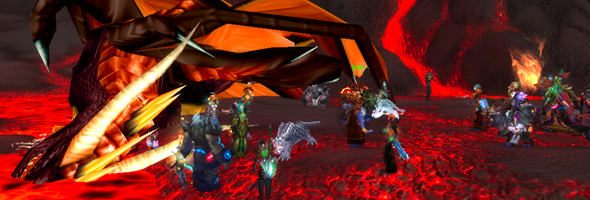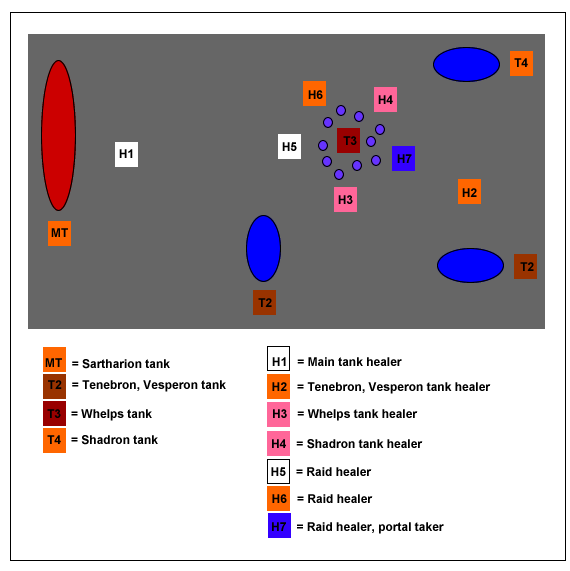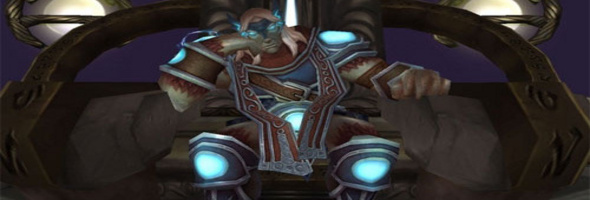
For other bosses in Ulduar, check the Ulduar Healing Strategy Page.
“Interlopers! You mortals who dare to interfere with my sport will pay… Wait–you… I remember you… In the mountains… But you… what is this? Where am–“
Thorim is the lord of storms and brother to Loken. He is one of the Keepers of Ulduar.
The fight is broken down into 3 phases, with phase 2 having two parts. First, lets see what Thorim can do.
Abilities
Sheath of Lightning – When the encounter begins, Thorim will coat himself in an almost impregnable sheet of lightning.
Charged Orb – Charges an orb in the arena with the power of storms. The tower will discharge Lightning Shock which can chain to multiple people in close range to each other.
Lightning Shock / charged Orb Example:
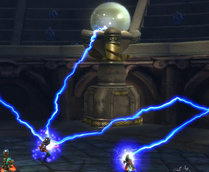
Storm Hammer – Thorim throws his hammer into the arena causing Deafening Thunder. It can interrupt your casting and places a debuff that increased casting times by 75% for 8 seconds
Summon Lightning Orb – Sends a ball of lightning down the corridor towards the players, laying waste to everything in its path.
Chain Lightning – Thorim casts a lightning bolt into the party that increases in damage the further it jumps.
Lightning Charge – Thorim absorbs the power of a nearby lightning orb and then discharges it in a cone back towards the orb he siphoned the power from. After the charge Thorim will hit faster and harder. This is a stacking buff, and acts as a passive enrage in phase 3
Lightning Charge example:
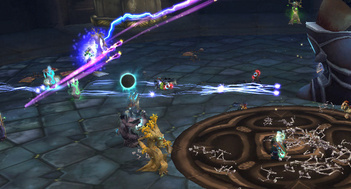
Unbalancing Strike – Reduces the tanks defense by 200.
Enrage – When you start phase 2 you have 5 minutes to reach him before he enrages and clears the raid out.
Adds
Thorim has a lot of friends who want to play with you.
Runic Colossus
Ancient Rune Giant
Those two are like mini bosses. They don’t hit too hard.
Dark Rune Warbringer
Dark Rune Evoker
Dark Rune Champion
Dark Rune Commoner
Waves of trash will consist of these mobs.
Execution
The fight itself has 3 phases, with phase 2 having two parts.
Phase 1:
You enter the arena to see a giant Jormungur facing off against opponents of the opposite faction.
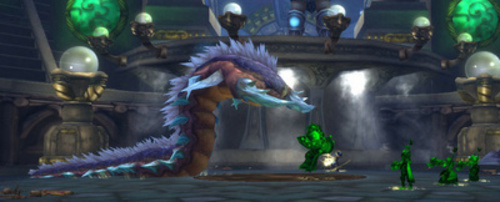
They are easily dispatched and don’t really hit hard on tanks. Clean them up and get ready for phase 2.
Phase 2:
Phase 2 is split into two sections, a Ramp/Gauntlet group, and an Arena/Pit group. We’ll talk about the ramp group first.
The Ramp group will normally consist of one tank, seven DPS, and two healers. Speed is the biggest factor here. The faster you get to the end of the hallway, the sooner you can start phase 3. For healers you want someone who can snap big heals, or heals on the move. We found that druids and holy paladins work incredibly well for the ramp group. Large effective heals and lots of mobility.
There will be three groups of Warbringers along your way and a giant golem at the end of the hall that sends death down one side at a time. We assigned someone to call out which side to move to. As a healer, don’t worry about keeping someone who stands in the line of fire from the golem alive, they’re going to die. It’s pretty easy to heal the Gauntlet, just keep the tank alive and burn through as fast as possible.
The Arena group has it’s own tree of woe to deal with. The aforementioned adds will be flooding into the arena to get a piece of us would-be adventurers for ruining their entertainment. The easiest way to do it is to have tanks set up an AoE pit in the center of the arena. We use three tanks (bear, paladin and warrior just for reference). The druid and the paladin tank the vast majority of the mobs while the warrior pulls the champions off to the side slightly (see triangle on the diagram) to keep them from whirlwinding the dps.
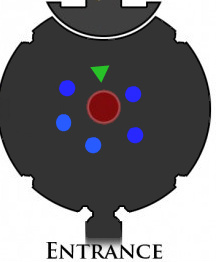
Healers (blue circles) should spread out around the AoE pit to minimize the impact of the Storm Hammers. Priests should be ready to mass dispel the Runic Shield from the evokers. Group healing helps a lot in this part of the fight. CoH, Chain heal, glyphed Holy Light and even Wildgrowth will help keep the DPS in the AoE pit up. Just keep an eye on aggro happy AoE damage dealers though, sometimes warlocks like to explode without warning here. Healers that are spread out should watch for Lightning Orbs and be ready to move quickly, lest they chain the damage to other players. If you get snap aggro from adds through healing, you should run through the AoE pit to give your tanks a chance to snag them with a taunt or even just Consecrate / Death and Decay to grab them. Continue to burn down the pit, picking off Evokers and Champions as you can until your ramp group reaches Thorim and starts phase 3. Name of the game is survival. Heal your rear off! keep everyone up, especially tanks and you’ll be good to go.
Phase 3:
Once you reach Thorim’s platform he jumps down into the arena. A tank has to pick him up right away while everyone else works on adds. Thorim hits reasonably hard when he connects so it is suggested to have a few healers on the tanks. Normally We put 3 healers on the two Thorim tanks, Druid, Paladin and a Disc priest have been wonderful for evening out damage and making Unbalanced Strike transitions easier. As the fight goes on, Thorim hits harder and harder, much in the way of Gruul the Dragonslayer, but three healers should be enough to keep the tanks alive. The rest of the raid and healers need to be spread out around the room, more than 10 yard away from someone if you can. When Thorim Chain Lightnings, it can have disastrous results.
While you’re healing keep your eyes peeled for a white pulsing line going between him and one of the pillars. At this point, you want to run away from that line as quickly as possible. After the line is done energizing him, he will cast an arch of lightning in a 60 degree cone towards wherever he pulled the power from. If you’re caught in it it will hurt. Stop your casting and move fast and then resume healing. The tanks will keep rotating so make sure they are topped off while your raid healers keep track of everyone else. Tank healers have to be careful to make sure they switch to the new tank quickly otherwise you run the risk of the new tank eating two large strikes back to back later in the fight.
In my opinion the hardest part of this encounter is phase 2 for arena healers. There is just a lot going on. There’s a ton of movement, a ton of raid damage and a ton of situational awareness needed to make it through. Heads up Healing comes in very handy in the arena as it lets you move before you’re splatted. It also helps you when you can see the mobs turn to go take out that AoEing warlock before they actually hit her (looking at you Jahadura!) and splatter their remains all over the arena floor. Once you get this part down, the rest of the encounter is no harder then anything else you’ve faced so far. Now for the good stuff.
Healer Items:
Once you free Thorim and he’ll leave behind the Cache of Storms, here’s some goodies he has
T8 Helm token
Scale of Fates – Trinket (Haste/Spellpower)
Pauldrons of the Combatant -Shoulders (Shamans)
Wisdom’s Hold – Shield (Paladins, Shamans)
Leggings of Lost Love – Legs (Priest, Druid)
Also a little poll here. My guild leader thinks Thorim sounds like Patrick Stewart, I think my guild leader is very mistaken. What do you guys think? Does Thorim sound like Patrick Stewart?
Until next time, Happy Healing







